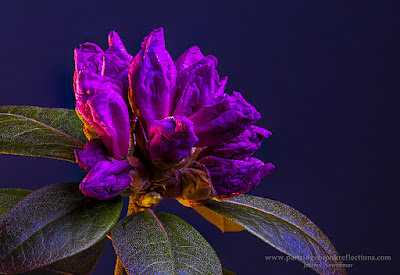 |
| Rhododendron Bloom |
Challenges of Outdoor Macro Photography
 Last time I
discussed some of the problems of outdoor macro photography. Most importantly, it is often difficult to
find a satisfactory balance between a small aperture to provide good depth of
field and a short shutter speed to freeze motion. This can be especially challenging in low
light situations, but bright light can cause its own problems with stark
shadows and blown-out highlights. Photography is all about finding the best
compromises, and with care and patience great images of nature’s fine detail
can be obtained outdoors. But since we
have been told to isolate, I thought it would be helpful to discuss the advantages
of bringing macro photography indoors.
Last time I
discussed some of the problems of outdoor macro photography. Most importantly, it is often difficult to
find a satisfactory balance between a small aperture to provide good depth of
field and a short shutter speed to freeze motion. This can be especially challenging in low
light situations, but bright light can cause its own problems with stark
shadows and blown-out highlights. Photography is all about finding the best
compromises, and with care and patience great images of nature’s fine detail
can be obtained outdoors. But since we
have been told to isolate, I thought it would be helpful to discuss the advantages
of bringing macro photography indoors.
My Spring Floral Cheat
 It is
usually about this time every “normal” year that I head out for my springflower photography “cheat”. I go to my
favorite local greenhouse (Walker’s Farm in Dummerston Vermont) and, while
Susan buys plants for the garden, I shoot an amazing variety of healthy flora,
all indoors with soft diffuse light and no problems with the wind.
It is
usually about this time every “normal” year that I head out for my springflower photography “cheat”. I go to my
favorite local greenhouse (Walker’s Farm in Dummerston Vermont) and, while
Susan buys plants for the garden, I shoot an amazing variety of healthy flora,
all indoors with soft diffuse light and no problems with the wind.  The only major difficulty is keeping people
from tripping on my tripod. I always get great shots and the plants are all
labeled for easy identification. It is
simple, and I am never the least bit ashamed of my lazy deceit. Sadly, this
year the damn Covid 19 has prevented me from visiting the greenhouse, and I have been forced to
create my own special environment.
The only major difficulty is keeping people
from tripping on my tripod. I always get great shots and the plants are all
labeled for easy identification. It is
simple, and I am never the least bit ashamed of my lazy deceit. Sadly, this
year the damn Covid 19 has prevented me from visiting the greenhouse, and I have been forced to
create my own special environment.
Trans-Illuminating Autumn
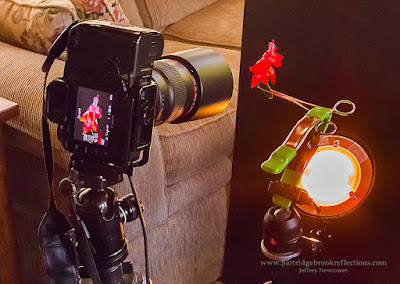 |
| My Sunroom "Studio" |
A few years
ago, I decided to bring a selection of autumn leaves indoors to use
trans-illumination to highlight their brilliant colors. My setup was simple, a bright light, a piece of black mat board and
my macro lens. In that situation, I was
shooting with the light shining through thin leaves and the effects were
stunning. To avoid difficulty with depth
of field, I pressed the leaves flat before shooting, and with the camera on a
tripod, I could shoot with a small aperture.
My only real challenge was to get Susan to allow me to clutter half of
our sunroom for the project.
Illuminating Spring
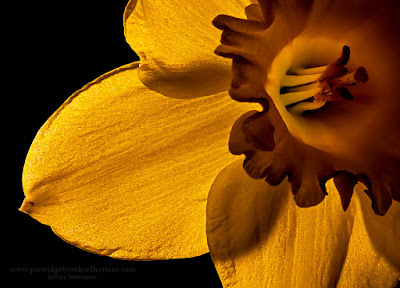
Over the last week I have worked to reproduce my indoor lighting to shoot the developing spring flora, and Susan is happy that I can set things up in my barn studio. I do not have the focused tensor lamp that worked so well for my autumn leaves, but I found that the intense trans-illumination was not as important.
 Unlike the flattened autumn leaves, spring buds
and flowers have greater dimension and are more opaque. To
achieve balance illumination, I found that I needed to add a variable amount of
front lighting, with one of my LED studio lights. I kept the large light source close, allowing
the light to wrap around the subjects.
Unlike the flattened autumn leaves, spring buds
and flowers have greater dimension and are more opaque. To
achieve balance illumination, I found that I needed to add a variable amount of
front lighting, with one of my LED studio lights. I kept the large light source close, allowing
the light to wrap around the subjects.
Focus
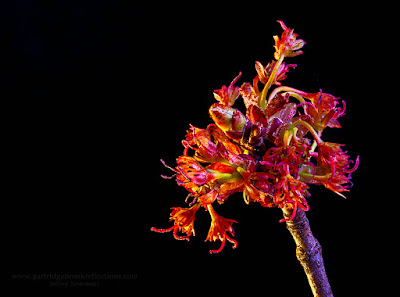 |
| Maple Buds |
In the
controlled Indoor setting, focus was much easier to manage. I could enlarge the depth of field with small
apertures, routinely shooting at f32.
The diffraction associated with such small apertures can cause softening
of image detail, but much of this can be corrected with sharpening in post-processing.
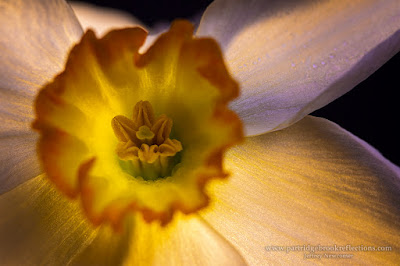 |
| Single Image f 5.6 |
Even with small apertures, macro
photography is associated with shallow depth of field, but a restricted DOF can
be used to direct attention to a small area of the image. Quite often this means leading the eye to the
stamen. A single exposure, with a small
aperture, can be a pleasant solution, but when you want the entire subject to
be sharp, focus stacking is a great solution.
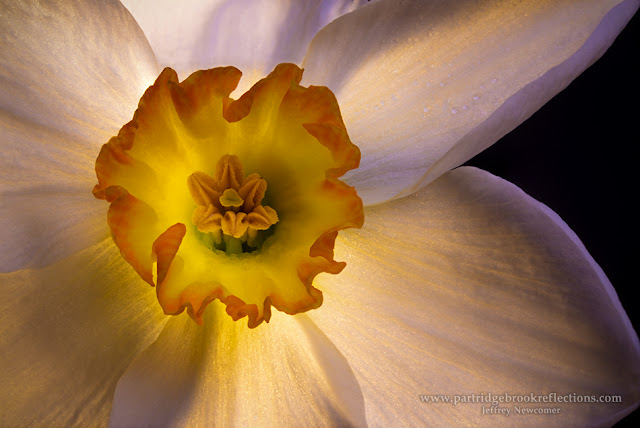 |
| Six Image Focus Stack |
Focus
Stacking
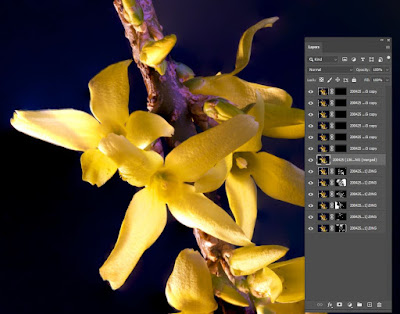 |
| Six Image Focus Stack with Blended and Touch-up Layers |
Focus stacking involves blending
multiple images taken at different plains of focus. I have discussed the details of this
procedure in previous articles. The
technique is not complicated but does require the use of image editing
software. If you are using Adobe software, Lightroom will not allow the
required manipulation of layers, but Photoshop
simplifies the process of aligning, blending and touching up the images.
 Although
variably focused images can be obtained in the field, it is much easier and
more precise when in the controlled studio environment. When both the subject and the camera are held
stationary, a sufficient number of pictures can be obtained to result in
sharply focused macro images. Indoors, I
routinely obtained six or more images each with subtle differences in focus and
with greater numbers of layers the post-blending touch-up process was much less
difficult.
Although
variably focused images can be obtained in the field, it is much easier and
more precise when in the controlled studio environment. When both the subject and the camera are held
stationary, a sufficient number of pictures can be obtained to result in
sharply focused macro images. Indoors, I
routinely obtained six or more images each with subtle differences in focus and
with greater numbers of layers the post-blending touch-up process was much less
difficult. Whether
indoors or out, there are great photographic opportunities as our New England
spring progresses. Images captured in
natural settings can be great, but consider experimenting with the control that
comes with bringing those flowers and buds inside. With a few simple tools, you will discover an
exciting new world of detail and beauty.
Whether
indoors or out, there are great photographic opportunities as our New England
spring progresses. Images captured in
natural settings can be great, but consider experimenting with the control that
comes with bringing those flowers and buds inside. With a few simple tools, you will discover an
exciting new world of detail and beauty. 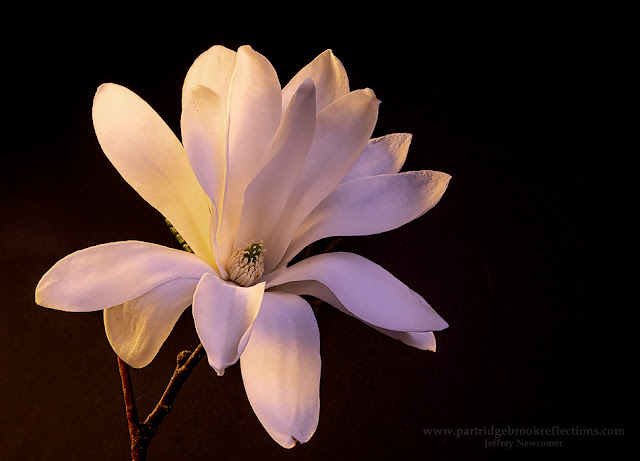 |
| Dogwood Bloom |
Check out these links :
- Macro Leaf Photography for the Late Autumn
- Focus I
- Focus II
- Floral Photography “Teed Up"
- Diffraction and Lens Sharpness
Jeffrey
Newcomer NEPG
www.partridgebrookreflections.com




No comments:
Post a Comment